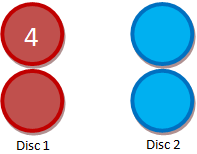 Brad has made two discs for a game.
Brad has made two discs for a game.
These discs should have numbers on each side but he's not sure what to put in the three empty spaces.
When Brad flips the discs and adds the numbers that he can see, he wants to get only sums of 8, 10, 11 or 13.
What does Brad need the missing numbers to be?
Solution:
The 4 on Disc 1 needs to be able to add to each of the two numbers on Disc 2 to give 8, 10, 11, or 13. Try picking a couple of numbers that make this work.
We'll try 4 and 6. So now you can make sums of 8 and 10. The 4 and the 6 on Disc 2 need to add to the other number on Disc 1 to make sums of 11 and 13. For this to work, the second number on Disc 1 needs to be a 7.
What if we had tried 6 and 9 as the two numbers on Disc 2? This time you can make sums of 10 and 13. The 6 and the 9 on Disc 2 need to add to the other number on Disc 1 to make sums of 8 and 11. For this to work, the second number on Disc 1 needs to be a 3.
You could also put a 4 and a 7 on Disc 2. This would mean that the other number on Disc 1 needs to be a 6.
Extension:
What if Brad had put a 2 instead of the 4, on disc 1?